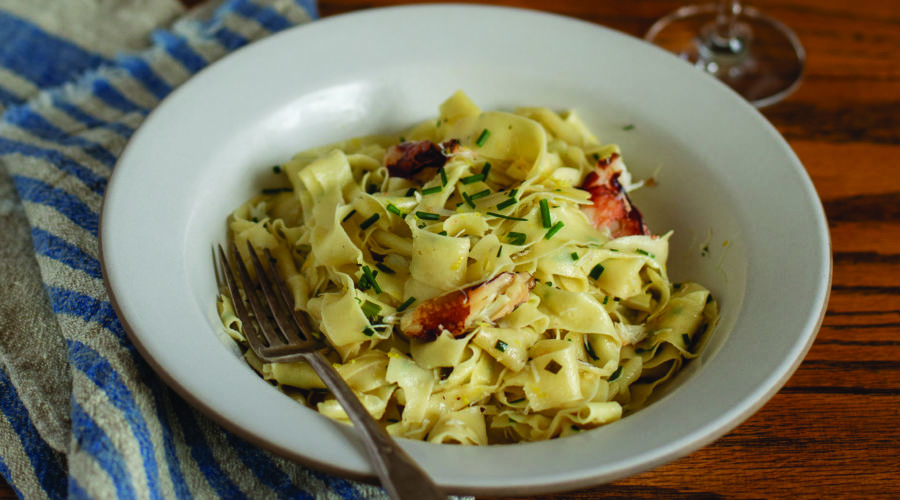Dungeness Crab Pasta

Here’s one of our favorite Dungeness crab dishes from Brian Clevenger of General Harvest Restaurant in Seattle, who originally shared the pasta recipe in The Pacific Northwest Seafood Cookbook by Naomi Tomky. Crab season never tasted so good.
Clevenger says, “So you finish up your crab dinner and have a few lumps left over . . . or maybe your crabbing excursion came up a little short: no problem. This recipe takes a tidbit of crab and extends it through a bowl of pasta as if you were shoveling lumps of meat into your mouth with every bite.”
Tomky adds, “While Clevenger specializes in making near-perfect pasta, I don’t recommend making your own noodles if you don’t have a pasta roller—it’s a lot of work and stores sell perfectly good fresh pasta. But if you either have a pasta machine or feel like taking on a project, these silky-textured, rich noodles make great company for the crab.”
Notes: The fresh pasta recipe here makes about twice as much as you’ll need for the recipe—you can freeze the other half and cook it straight from the freezer the next time you want a quick treat. If you’re buying store-bought fresh pasta, get about 4 ounces per person.
Excerpted from The Pacific Northwest Seafood Cookbook. Text copyright 2019 by Naomi Tomky, photograph copyright 2019 by Celeste Noche. Reproduced by permission of The Countryman Press. All rights reserved.
How to Make It
Boil heavily salted water in a large pot.
Heat the butter in a large pan over medium heat. Once it melts, sauté the diced fennel until it just begins to color, about 3 minutes.
Add the pasta to the salted water and cook for 2 minutes (or a few minutes longer if using store-bought pasta—you want it just short of al dente). Reserve ¼ cup of the pasta water. Add the noodles and reserved pasta water to the fennel pan and cook another 2 minutes on high heat.
Stir in the crab, lemon zest, crème fraîche, and chives. Remove the pan from the heat and season it with the salt, pepper, and lemon juice.
FOR THE FRESH NOODLES: Put the two flours and the salt in the bowl of a stand mixer (or any large bowl if you’re making the pasta by hand), then separately mix together the egg yolks, whole egg, olive oil, and ¼ cup of warm water in another bowl.
Using the dough hook on low speed, combine the dry ingredients (or by hand, if you’re not using a mixer). Slowly add in the egg mixture. Add more warm water as needed, up to another ¼ cup, until the dough begins to form (kneading, if by hand).
Transfer the dough from the bowl to a well-floured surface and, using your palms, fold the dough over itself, repeating until a tight ball forms, about 6 to 8 minutes.
Wrap the dough in plastic and let it rest at least 30 minutes before rolling.
Roll out the dough as thin as possible in a pasta machine, likely in 6 to 8 sheets, dusting with flour as necessary to prevent sticking. Then cut the noodles to a little over ¼ inch wide. Hang them to dry on a chair back or laundry rack as you finish cutting.
Ingredients
Directions
Boil heavily salted water in a large pot.
Heat the butter in a large pan over medium heat. Once it melts, sauté the diced fennel until it just begins to color, about 3 minutes.
Add the pasta to the salted water and cook for 2 minutes (or a few minutes longer if using store-bought pasta—you want it just short of al dente). Reserve ¼ cup of the pasta water. Add the noodles and reserved pasta water to the fennel pan and cook another 2 minutes on high heat.
Stir in the crab, lemon zest, crème fraîche, and chives. Remove the pan from the heat and season it with the salt, pepper, and lemon juice.
FOR THE FRESH NOODLES: Put the two flours and the salt in the bowl of a stand mixer (or any large bowl if you’re making the pasta by hand), then separately mix together the egg yolks, whole egg, olive oil, and ¼ cup of warm water in another bowl.
Using the dough hook on low speed, combine the dry ingredients (or by hand, if you’re not using a mixer). Slowly add in the egg mixture. Add more warm water as needed, up to another ¼ cup, until the dough begins to form (kneading, if by hand).
Transfer the dough from the bowl to a well-floured surface and, using your palms, fold the dough over itself, repeating until a tight ball forms, about 6 to 8 minutes.
Wrap the dough in plastic and let it rest at least 30 minutes before rolling.
Roll out the dough as thin as possible in a pasta machine, likely in 6 to 8 sheets, dusting with flour as necessary to prevent sticking. Then cut the noodles to a little over ¼ inch wide. Hang them to dry on a chair back or laundry rack as you finish cutting.

